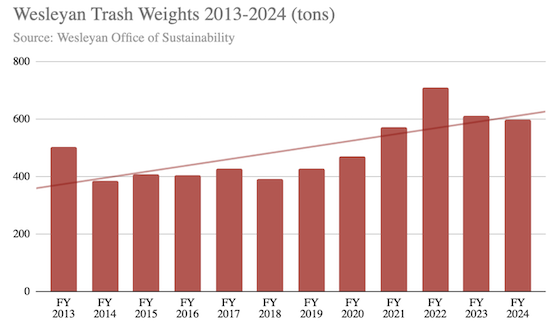
For municipalities, diverting trash waste offers not only an ecological but also a fiscal benefit.
In Middletown, trash disposal cost the City $522,476.17 in 2023, according to data shared by the municipality’s sustainability office.
When I met with Middletown Recycling Coordinator Kim O’Rourke at the City’s transfer station, she expressed deep frustration with the runaway costs of the Connecticut trash industry.
“The trash industry has a very strong hold on Connecticut,” O’Rourke said. “The trash families—the guys who run All Waste and CWPM [two Connecticut-based waste management companies]—have a [stranglehold] on the legislature. It’s to their benefit to get as much waste as possible, because they make more profit.”
Alhough Middletown services residences in the sanitation district, private haulers, such as All Waste and CWPM, service the majority of Middletown.
In 2022, in an attempt to reduce trash waste and disposal costs, Middletown introduced a unit-based Pay As You Throw program, or, as O’Rourke cleverly christened it, a “Save As You Throw” program.
The program requires residents in the sanitation district to purchase sanctioned orange trash bags, which are available at a number of local retailers. They also offer a subsidized program for qualified applicants, who receive two bags per week for a $24 yearly fee. Middletown will only collect a resident’s curbside trash if it’s in one of these orange bags.
According to O’Rourke, the program is designed to reduce trash waste, which is the only viable method to reduce disposal costs. In 2023, 2,000 Middletown residences within the sanitation district produced 5,596 tons of trash, at the disposal cost of $93.36 per ton. Middletown’s 2025 contracts will charge $124 per ton.
The trash reduction program worked. In the first year of implementation, the sanitation department observed a 32% reduction in trash waste.
“We’ve been trying to reduce waste for the past 20 years,” O’Rourke said. “No other town has done that.”
In theory, the program will also save residents money. Middletown cut the yearly sanitation bill from $400 to $280, and if a residence only uses two 15-gallon bags a week, they’ll break even with the former costs, their website explains. If residents generate less trash, they’ll save more. As stated in on Middletown’s sanitation website, without this reduction, costs will continue to increase indefinitely.
Still, asking residents to pay per unit has been a difficult sell.
“It’s an emotional topic,” O’Rourke said.
That might be an understatement.
On Jan. 6, 2024, a member of the Middletown, CT Community page on Facebook shared a City press release that the sanitation department would begin compliance checks later that week. 65 people responded in outrage.
“It’s what you get when electing a 12-yr-old democrat Wesleyan student to run our city. Unreal,” one commenter, going by Micki Charton, wrote.
“What a waste (pun intended) of taxpayer’s money,” another commenter wrote, under the name Betty Oszurek.
In response, the City website lists 54 frequently-asked questions about the program, attempting to deal with potential issues such as “Why can’t the city give everyone an in-home electric ‘composter’ instead?” and a hopeful “How do I get involved in advertising the program?”
The Waste Management Process Continues
While parts of Wesleyan exist inside the City’s sanitation district, namely Low and High Rise Apartments and senior housing, the University contracts most trash pickups with All Waste, according to Associate Director of Facilities Management Jeffrey Sweet.
All Waste maintains their own transfer station in Middletown where waste is packaged and shipped to landfills in Ohio.
For Wesleyan residences inside the sanitation district, the department transports curbside waste to a trash-to-energy facility in Lisbon, Conn.
According to O’Rourke, at Lisbon, operators dump the collected trash into a large furnace. In the 1980s, Connecticut shifted from disposing of trash in landfills to incinerating it. Incineration doesn’t release methane, as landfills do, but it does emit carbon dioxide.
40 years ago, Connecticut developed six waste-to-energy facilities. Now only four remain, ranging from 26–34 years old and nearing the end of their lifespans. The closure of the Hartford Materials Innovation and Recycling Authority’s waste-to-energy plant in 2022 forced the state to reroute 860,000 tons of trash to landfills in Ohio and Pennsylvania.
“Connecticut can’t handle the amount of trash we produce,” O’Rourke said.
Thomas Lyons can be reached at trlyons@wesleyan.edu.



Leave a Reply